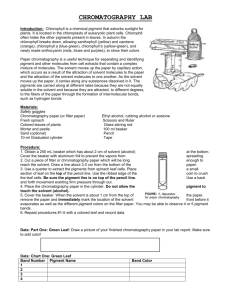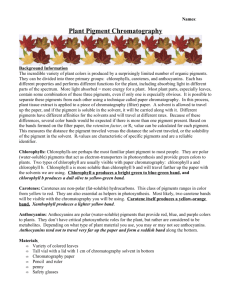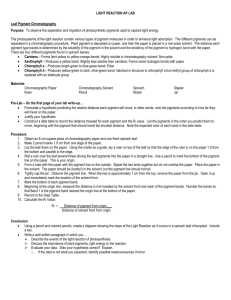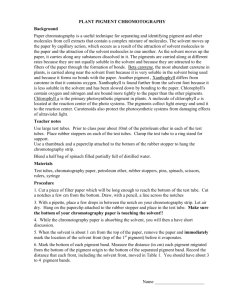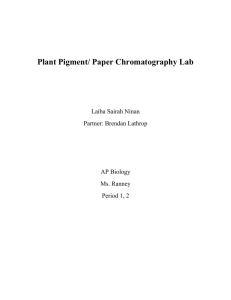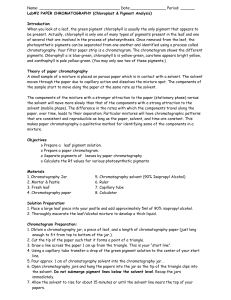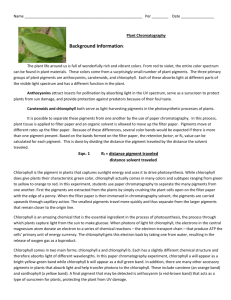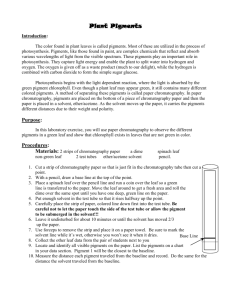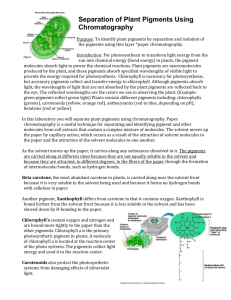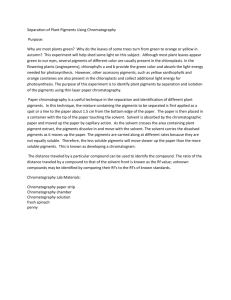Leaf Chromatography Lab
advertisement
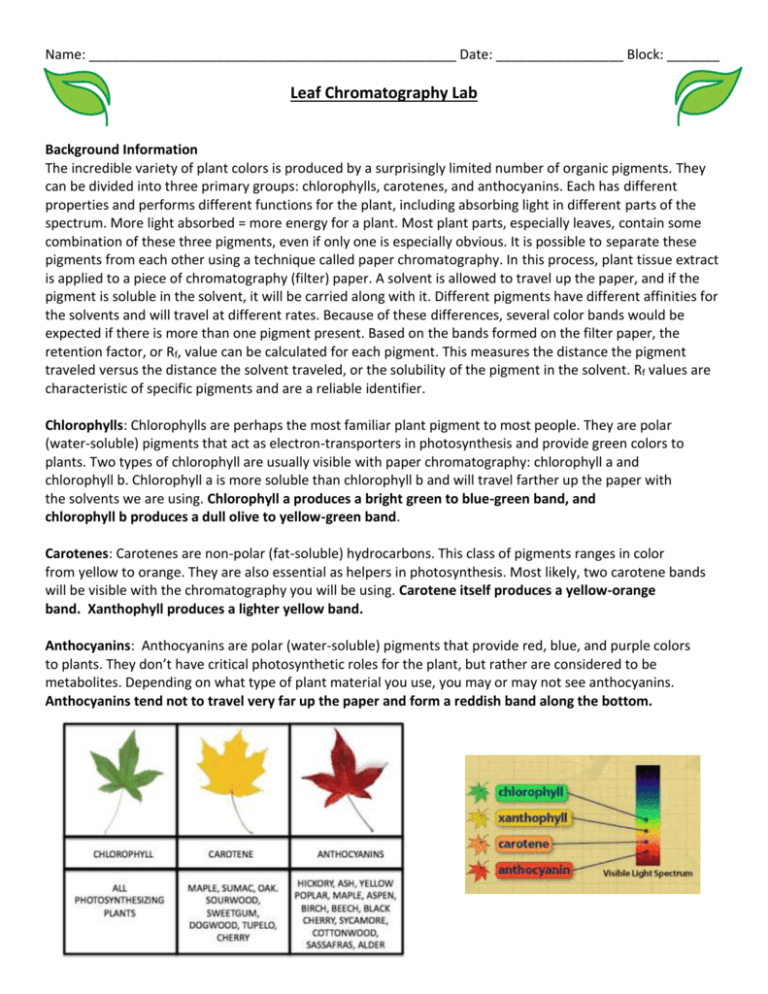
Name: _________________________________________________ Date: _________________ Block: _______ Leaf Chromatography Lab Background Information The incredible variety of plant colors is produced by a surprisingly limited number of organic pigments. They can be divided into three primary groups: chlorophylls, carotenes, and anthocyanins. Each has different properties and performs different functions for the plant, including absorbing light in different parts of the spectrum. More light absorbed = more energy for a plant. Most plant parts, especially leaves, contain some combination of these three pigments, even if only one is especially obvious. It is possible to separate these pigments from each other using a technique called paper chromatography. In this process, plant tissue extract is applied to a piece of chromatography (filter) paper. A solvent is allowed to travel up the paper, and if the pigment is soluble in the solvent, it will be carried along with it. Different pigments have different affinities for the solvents and will travel at different rates. Because of these differences, several color bands would be expected if there is more than one pigment present. Based on the bands formed on the filter paper, the retention factor, or Rf, value can be calculated for each pigment. This measures the distance the pigment traveled versus the distance the solvent traveled, or the solubility of the pigment in the solvent. Rf values are characteristic of specific pigments and are a reliable identifier. Chlorophylls: Chlorophylls are perhaps the most familiar plant pigment to most people. They are polar (water-soluble) pigments that act as electron-transporters in photosynthesis and provide green colors to plants. Two types of chlorophyll are usually visible with paper chromatography: chlorophyll a and chlorophyll b. Chlorophyll a is more soluble than chlorophyll b and will travel farther up the paper with the solvents we are using. Chlorophyll a produces a bright green to blue-green band, and chlorophyll b produces a dull olive to yellow-green band. Carotenes: Carotenes are non-polar (fat-soluble) hydrocarbons. This class of pigments ranges in color from yellow to orange. They are also essential as helpers in photosynthesis. Most likely, two carotene bands will be visible with the chromatography you will be using. Carotene itself produces a yellow-orange band. Xanthophyll produces a lighter yellow band. Anthocyanins: Anthocyanins are polar (water-soluble) pigments that provide red, blue, and purple colors to plants. They don’t have critical photosynthetic roles for the plant, but rather are considered to be metabolites. Depending on what type of plant material you use, you may or may not see anthocyanins. Anthocyanins tend not to travel very far up the paper and form a reddish band along the bottom. Procedure 1. Get a vial with a lid that has ~ 1 cm of chromatography liquid in the bottom and a green leaf. 2. Carefully cut a piece of chromatography paper that is about 2 inches long. Do not touch the paper with your fingers – only touch the edges of it! 3. Use a ruler to make a pencil line across the bottom of the strip of paper 1 centimeter from the bottom. Trim the bottom of your paper to an arrow point. 4. Use a coin to extract the pigments from the green leaf. Place a small section of leaf on top of the pencil line. Use the edge of the coin to crush the cells. Be sure that the pigment line is on top of the pencil line. Repeat this about 8 to 10 times using a new portion of the leaf until you get a dark line at the bottom. 5. Place the chromatography paper into the vial so that the pointed end barely touches the solvent liquid. Do not allow the pigment to be in the solvent. 6. Put the lid on the vial. When the solvent is about 1 cm from the top of the paper, remove the paper and immediately mark where the solvent reached before it evaporates. 7. Once the paper is dry, use the light box to draw a line across the bottom of each pigment band. Depending on the species of plant used, you may be able to see 4 to 5 pigment bands. 8. By measuring from the point of origin to the bottom of each pigment band, the R f value for each pigment can be calculated using the following formula: Rf = distance of pigment from origin distance of solvent front from origin Sketch: Attach Paper Here: Data Tables: Band Number 1 Distance moved (mm) Band Color 2 3 4 5 Distance in millimeters the solvent moved ____________________ Pigment Carotene (yellow-orange) Rf Value Xanthophyll (yellow) Chlorophyll a (bright green) Chlorophyll b (olive or yellow-green) Anthocyanin (red) Rf = distance of pigment from origin distance of solvent front from origin Analysis: 1. Which pigments did you discover in your leaf sample? ___________________________________________ __________________________________________________________________________________________ 2. The thickness and intensity of each band of color on your paper indicates the amount of pigment present in the leaves. Using this criteria, which pigment is the most abundant in your leaf? ______________________ Which pigment is the least abundant? __________________ 3. Compare your Rf values to another group? Are they close (They should be.) If not, suggest a reason why. __________________________________________________________________________________________ 4. Why do you think some pigments moved farther than others? (hint: think about polarity) __________________________________________________________________________________________ __________________________________________________________________________________________ 5. Based on what you have seen in this activity, come up with an explanation for how green leaves turn such brilliant colors in the fall. _____________________________________________________________________ __________________________________________________________________________________________ 6. Based on your knowledge of the light dependent and light independent reactions, what role does chlorophyll play in the steps of photosynthesis? ___________________________________________________ __________________________________________________________________________________________ 7. What is the advantage to a plant of having several different pigments rather than just one? __________________________________________________________________________________________ __________________________________________________________________________________________ 8. Could you use chromatography to separate pigments for anything else? (Hint: Think about shows like CSI, NCIS, and Cold Case) _________________________________________________________________________ __________________________________________________________________________________________

